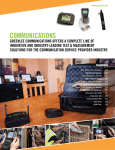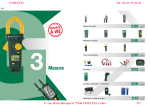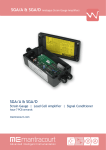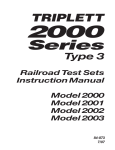Download 981040 PEI Booklet - Lashen Electronics
Transcript
PROGRESSI VE ELECTRONICS, INC. May 1998 325 S. El Dorado, Mesa Arizona 85202 1-800-528-8224 Troubleshooting and Maintaining Electrically Controlled Zone Irrigation Systems Issue 20 CONTENTS 1. Troubleshooting at the Controller ................................Page 2 (Using Volt Ohmmeter) 2. Troubleshooting............................................................Page 3 (Using the Model 24) 3. Activating Solenoids ....................................................Page 3 (Model 24) 4. Identifying Wires.........................................................Page 3 (Models 77A & 200EP) 5. Locating the Path of Buried Wires...............................Page 4 (Models 501 & 508S) 6. Inductive Coupler .........................................................Page 4 7. Using the Inductive Antenna........................................Page 5 (Model 501) 8. Locating Wire Nicks or Breaks....................................Page 6 (Model 2003) 9. Locating Solenoid Valves, Wire Breaks and Large Nicks (Model 521) ......................................Page 9 10. Model 528 Wire and Valve Locator ...........................Page 12 11. General Hints .............................................................Page 14 Figure 11 Figure 12 Figure 13 Figure 14 Figure 15 Figure 16 Figure 17 Figure 18 Figure 19 Figure 20 Figure 21 Figure 22 Figure 23 Figure 24 Figure 25 Figure 26 Figure 27 Figure 28 Figure 29 Figure 30 NECESSARY TEST EQUIPMENT FIGURE INDEX Figure 1 Figure 2 Figure 3 Figure 4 Figure 5 Figure 6 Figure 7 Figure 8 Figure 9 Figure 10 Flow Chart (Full Page) ......................................Page 2 Sending Tone From Clock.................................Page 3 Sending Tone From Valve .................................Page 3 Identifying Single Conductor ............................Page 4 Locating the Path of Buried Wires ...................Page 4 Determining Depth With 501 ............................Page 4 Determining Depth & Path With 508S .............Page 4 The Inductive Antenna ......................................Page 5 Placement of Antenna........................................Page 5 Placement of Antenna for Longer Distances.....Page 5 Searching for Underground “Utilities” .............Page 6 Pulser Transmitter Set-Up .................................Page 6 Pulser Receiver Set-up ......................................Page 7 Ground Return Fields ........................................Page 7 Nulling Receiver First Time ..............................Page 8 Nulling Receiver Second Time..........................Page 8 False Reversals ..................................................Page 8 Probing Path to Find Fault ................................Page 9 Four Quadrant Kick to Center.........................Page 10 521 Transmitter Set Up ...................................Page 10 Locating Wire Path With 521 ..........................Page 10 Locating End of Broken Wire .........................Page 10 Locating Wire Nick .........................................Page 11 Determining Depth ..........................................Page 11 Locating Solenoid Valves ................................Page 12 Tracking Path with 528 ...................................Page 12 Locating Broken Wires....................................Page 13 Measuring Depth .............................................Page 13 Locating Solenoids ..........................................Page 13 Examples of Hot Spots....................................Page 14 1. 2. 3. 4. 5. 6. 7. Model 24 Solenoid Activator and System Tester Model 77A Tone Generator Model 200EP Inductive Amplifier Model 501 & 508S Cable Locators Model 2003 Short To Earth Ground Locator Model 521 Broken Wire 7 Solenoid Valve Locator Model 528 Compact Wire & Solenoid Valve Locator All of the above equipment is manufactured by Progressive Electronics, Inc., Mesa, Arizona, and are pictured on page 15. PROGRESSIVE ELECTRONICS TROUBLE SHOOTING AND MAINTAINING ELECTRICALLY CONTROLLED ZONE IRRIGATIONS SYSTEMS 1. TROUBLE SHOOTING AT THE CONTROLLER. Automated irrigation systems are a dream when working properly. When a problem develops it can be a long and tedious process to solve. Learn to use your ohmmeter and at least one of your problems is over. the other half is easy, too, if you have the proper locating equipment. The FLOW CHART is designed to take you completely through a malfunctioning irrigation system and insure your ability to identify and solve your problems, step by step. (See Fig. 1) With the aid of a volt ohmeter, this section should help you determine what conditions exist so you can begin to solve your problems. FLOW CHART LEGEND 嘷 Circles indicate start or end. 〫 Diamond shape boxes indicate decision points. □ Square boxes indicate things to do. START MASTER VALVE ON TURN CLOCK ON ALL OK END SEQUENCE CLOCK NOTHING WORKS TURN CLOCK OFF SOME GOOD SOME BAD LIST BAD ONES CHECK FUSE SELECT FIRST BAD BAD GOOD MEASURE 110V TO CLOCK MEASURE CLOCK VOLTAGE STATION TO COMMON NO VOLTAGE VOLTAGE OK REPLACE FUSE NO VOLTAGAE VOLTAGE OK MEASURE VOLTAGE TO EARTH GROUND REPAIR CLOCK TURN CLOCK OFF RX1 RX1K NO VOLTAGE VOLTAGE ON HOT CHECK 110V AT SOURCE CHECK RESISTANCE FROM NEUTRAL TO EARATH GROUND DISCONNECT STATION & COMMON CHECK RESISTANCE FROM STATION TO COMMON SELECT STATION #1 MORE THAN 180 ⍀ CHECK RESISTANCE FROM STATION TO GROUND & COMMON TO GROUND STATION LESS THAN COMMON CHECK RESISTANCE FROM HOT & NEUTRAL TO EARTAH GROUND FIX FIND FAULT FIND VALVE COMMON LESS THAN STATION SOURCE OK DISCONNECT HOT & NEUTRAL FIND FAULT IN NEUTRAL LESS THAN 180 ⍀ FIX BLEED VALVE VALVE GOOD VALVE BAD FIND FAULT FIX VALVE NO VOLTAGE REPLACE SOLENOID FIND FAULT FIX Figure 1 – Flow Chart 2 TURN CLOCK ON FIX SEQUENCE CLOCK FUSE BLOWN TURN CLOCK OFF REPLACE FUSE OK END 2. TROUBLE SHOOTING (Using the Model 24. Picture on page 15.) The Station Master, Model 24, is a portable hand held irrigation system diagnostic tester and solenoid activator. 4. IDENTIFYING WIRES (Using 77A & 200EP) How to identify a single conductor from the bundle of the same colored wires. A. Battery Test Place the toggle switch in the “ON” position and connect the leads together. If the LED glows, the batteries are suitable for use. (Batteries must supply at least 12.5V for “good” indication) B. Current Test (At Clock) With the clock on and turned to the station under test, place the Station Master in the “OFF” position and connect one lead to the station wire and the other to the common. If the LED glows, the clock is supplying enough current to operate solenoids. Figure 2 – Sending Tone From Clock C. Wire Test (At Valve) A. To do this, first you have to send a tone down the subject wire using the 77HP Tracer. You can start at the clock or send the tone back towards the clock. (See Figs. 2 & 3) NOTE: TO INSURE PROPER CONNECTION, PLACE THE WIRE FAR ENOUGH INTO THE JAW OF THE ALLIGATOR CLIP SO THE PIN WILL PIERCE THE INSULATION. The red lead of the 77HP is clipped to the wire being identified and the black lead to an earth ground using a screwdriver. Move the switch to the tone position and return to the location where identification will be made. Turn the clock on and cycle to the station under test. Go out to the valve and with the Station Master in the “OFF” position, hook the leads to the station and common wires and note condition of LED. NOTE: MAKE SURE THAT ALL OTHER EQUIPMENT IS DISCONNECTED FROM THE CIRCUIT BEFORE PERFORMING ANY TEST. (i.e., 521, 2003) If the LED glows, this indicates the station and common wires are in “good” condition. (The clock must be supplying 24 VOLTS with less than 180 OHMS of loop resistance to indicate a “good” condition.) 3. ACTIVATING SOLENOIDS (Model 24) NOTE: THE PRESENCE OF AC VOLTAGES IN THE “ON” POSITION WILL DAMAGE THE MODEL 24. To activate a solenoid at the valve, make sure the clock is off and connect the leads to the station and common wires, then turn the Station Master “ON”. This will activate the solenoid. The Model 24 must be turned “OFF” then “ON” to activate a second solenoid. The Station Master will hold a solenoid open for over three (3) hours with fresh batteries. Figure 3 – Sending Tone From Valve B. Now you have to find the one wire that is carrying the tone. Pick up the 200EP Line Aid and depress the large black button on the side and touch the tip of the 200EP to the insulation of the wires in the ditch. A light tone may be heard from all the wires but the tone will be tremendously louder on the subject wire. If there is a loud tone on several wires, keep turning the volume down on the 200EP and re-touch the wires. If a single wire cannot be determined, earth ground all other wires at the clock. The wire under test will be the only one with tone. (See Fig. 4) The only field maintenance required by the Model 24 is the periodic replacement of the two (2) 9v alkaline batteries. (Eveready #522 are recommended.) Remove the four (4) screws on the back, snap in fresh batteries and reassemble. 3 Figure 4 – Identifying Single Conductor 5. LOCATING THE PATH OF BURIED WIRES (Using 501 and 508S) THESE UNITS ARE NOT DESIGNED TO LOCATE SOLENOIDS OR GROUND FAULTS. Models 501 (The Tracker) and 508S (The Wire Finder) are most widely used for locating the path and depth of the buried wires in a sprinkler irrigation system. Both units transmit the same high radio frequency; however, the 501 is capable of distances up to 4,000 feet and depths to 7 feet. The 508S is a lower powered version, good for distances around 1,000 feet and depths to 3 feet. Figure 6 – Determining Depth With 501 A. The transmitters of these units have two black leads, one of which is connected directly to the wire end or metallic pipe and the other to earth ground with a screwdriver. Turn the transmitters on and you are ready to track the wires. The 501 receiver works on a “peak” signal when directly over the path and the 508S “nulls” (absence of signal) over the path. Walk completely around the transmitters (fifteen to twenty feet away) with the receiver until the direction of the path is determined, then simply follow the signal. (See Fig. 5) B. To track the path of a “system,” remove only the station wire and the common wire from the clock. Connect one transmitter lead to the station wire and the other to the common. Signal will travel all through the system going down the station wires, through the coil in the solenoid, then back out the common. This application enables you to “blueprint” a system and create your own “as built.” Figure 7 – Determining Depth & Path With 508S C. Depth of the wire can be determined with both the 501 and 508S using the 45 degree triangulation method. (See Fig. 6 & 7) 6. INDUCTIVE COUPLER A. DESCRIPTION The Inductive Coupler is designed to induce a tracking tone into a subject cable or wire without establishing metallic contact. (See page 15) The Inductive Coupler is constructed of plastic and iron, measures 4.5"x10x7.5", weighs 1 pound and can accomodate up to a 3" cable. B. OPERATION Clamp the Inductive Coupler around the insulation of the buried cable to be tracked. Connect both transmitter leads to Figure 5 – Locating the Path of Buried Wires (501) 4 Proceed down the cable path following the peak signal. the two terminals on the face of the coupler. Turn transmitter on to approximately a #5 output setting and radius the immediate area with the tracker receiver to determine path. The power output may be increased for greater distance. Proceed down cable path following the peak signal. NOTE: AS PROGRESS IS MADE DOWN THE CABLE PATH, GRADUAL INCREASES IN THE GAIN CONTROL OF THE RECEIVER WILL BE NECESSARY TO MAINTAIN RECEPTION. 7. USING THE INDUCTIVE ANTENNA (Model 501) Eventually, reception will be effectively lost, even at the maximum transmitter setting. Retrieve the antenna and place it at the point where the signal was last effectively received. Resume tracking the line and repeat the relocation of the Inductive Antenna as necessary. A. DESCRIPTION The Inductive Antenna (See Fig. 8) is used to apply a tracking tone into a cable, wire or metallic pipe by radiating a signal from the ground surface. This method is used when there is no accessible way to make a direct connection. The Inductive Antenna or transmitter loop is fitted inside the carrying case of the 501 System and is powered by the Model 500HP transmitter. C. SEARCHING FOR UNDERGROUND UTILITIES The activated 500CAA Inductive Antenna will radiate the tracking signal through surface and the target utility will receive the signal and effectively transmit it down its path. One craftsperson will carry the antenna case close to the ground and move in a specified direction. B. OPERATION Plug the two antenna leads into the 500HP transmitter. (See Fig. 8) Another craftsperson will hold the receiver (500R) a distance of at least 20 ft. away and simultaneously move parallel with the first person. When the receiver is directly over a utility, a strong signal will be detected. (See Fig. 11) Keep in mind that even though this is the easiest and most convenient way to locate, caution should be used because the radiated signal may be induced into other utilities. D. APPLICATION TIPS Remember that any conductive line in the immediate area can collect the radiated signal. In locations such as trailer parks or other areas with congested facilities, minor reductions in the transmitter output level may eliminate unnecessary signal bleed. Figure 8 - The Inductive Amplifier Turn transmitter to a # 7 output setting, place the transmitter in its compartment with the leads facing to the rear of the case. (See Fig. 9) Place activated antenna on the ground parallel to and within approximately one foot to either side of the utility to be tracked. (See Fig. 9) The very nature of the Inductive Antenna may be a problem to the operator if he is not prepared to pick up the tone from the antenna itself. Begin using the receiver 20 feet or more away from the antenna to avoid receiving signal on a direct basis. Radius the area approximately 20 feet away from the Inductive Antenna with the Tracker receiver to determine the path. Figure 9 applies to situations involving shorter runs or work relatively close to the antenna. Figure 9 – Placement of Antenna Figure 10 - Placement of Antenna For Longer Distances 5 Figure 11 - Searching for Underground “Utilities” To achieve maximum distance, orient the activated antenna parallel to the suspect path, only set the Tracker II case up on its back, as shown in Figure 10. LOCATE THE PATH OF THE WIRES. This has to be pre-determined by using Models 501, 508S, 528 or 521. (Refer to Sections 5 & 6) Once the path is flagged or marked, you are ready to use the Pulser. DO NOT CONNECT TO LIVE CIRCUITS ABOVE 240VAC OR TOUCH THE RED AND BLACK LEADS OF THE TRANSMITTER. The Inductive Antenna is permanently installed and is weather sealed. No attempt should be made to field repair the unit. Provisions have been made to retrofit existing carrying case with the Inductive Antenna. 8. NOTE: THE MODEL 2003 PRODUCES HIGH VOLTAGES. DISCONNECT ALL WIRES FROM THE CONTROLLER WHEN FAULT LOCATING. LOCATING WIRE NICKS OR BREAKS (Using Model 2003) A. The most effective way to use the Pulser is to first isolate both ends of the suspected faulted wire. For example, if the subject wire happens to be a station wire, take it loose from the clock and at the valve. The Pulser, Model 2003, is capable of pinpointing all shorts to ground in direct buried wires, ranging from clean breaks to small pinhole leaks. If the suspect wire is the common, again isolate. Let’s say that stations 1 through 6 work fine and 7 and 8 do not. NOTE: THE PULSER, MODEL 2003, WILL NOT Figure 12 - Pulser Transmitter Set-Up 6 Now, begin to probe the earth parallel to the predetermined path of the wire working away from the transmitter. Every time the transmitter pulses, a kick will be observed on the receiver indicating the direction of the fault. The kick will decrease in strength as you move down the path and sometimes it will completely disappear. Signal will reappear and increase in strength as you approach the fault. (See Fig. 14) You can speed up the fault locating process by covering more distance between the points where you insert the A-Frame into the ground. These distances are dictated by the strength or weakness of the kicks. For example, you are probing the path and at approximately 30 feet away from the transmitter, you start to lose the intensity of the “kicks” even after you have turned the receiver knob all the way up. This means that you can pick up and move down the path in 30-foot increments. If the distance is 100 feet, move down and probe the path every 100 feet. Figure 13 - Pulser Receiver Set-Up Isolate the common at valve 6 and 7, then start or set up at valve 6 and work the path between them; then do the same between 7 and 8. This process of the ground return fields produced by an earth gradient fault locator is shown in Figure 14. Continue probing the path until a “reversal”, or “black kick” occurs. When this happens, we know the fault lies somewhere between the last ground reference point and where you are now. (See Fig. 15) B. The transmitter set-up begins with connecting the red lead to the faulted wire and the black lead to earth ground with the stake provided. (See Fig. 12) When the transmitter is turned on, it discharges a voltage burst approximately every three seconds. This voltage travels out the suspect wire, bleeds to earth ground at the fault and returns in a straight line to the ground stake or reference point. (See Fig. 14) D. To narrow this distance down, you slowly move the AFrame back toward the last ground reference point or in the direction of the “black kick”. Continue this until another reversal or “red kick” occurs. Now we know the fault is somewhere between the two ground probes of the A-Frame. When the A-Frame evenly straddles the fault, the meter will null. Mark this spot. (See Fig. 16) NOTE: IF THE CLOCK IS INDOORS, THE BLACK LEAD MUST BE CONNECTED TO ITS OWN GROUND STAKE AND AT THE LOCATION WHERE THE WIRES EXIT THE BUILDING. DO NOT USE AN ELECTRICAL GROUND OR A WATER PIPE INSIDE. E. Repeat this procedure, only now at right angles to the path and mark where the second null occurs. C. Attach the Pulser receiver to the A-Frame and connect the cord set. Insure that the words “Front” on the receiver and the A-Frame are on the same side. (See Fig. 13) Figure 14 - Ground Return Fields 7 Figure 15 - Nulling Receiver First Time Figure 16 - Nulling Receiver Second Time Figure 17 - False Reversals 8 Figure 18 - Probing Path to Find Fault Your two marks should form an X and the fault lies directly below the X. (See Fig. 17) Progress outward in small increments. Continue doing this watching the meter and anticipating the reversal. When the reversal happens, bring the inward leg in small increments until the meter nulls. Gather the slack and attach it to the outside leg of the A-frame. Bring the A-frame to the ground steak on the other side of the paved area and insert the lead leg into the ground near the ground stake. Hold on to the wire, which is doubled now, and walk with them back on to the slab. The fault lies below the end of the loop. F. SPECIAL FAULT LOCATING PROBLEMS: False Reversals False Reversals may occur when the path of the faulted conductor serpentines and crosses the “ground return line” (See Fig. 18) The “ground return line” is the path the voltage is seeking on its way back from the ground fault to the ground stake. 9. LOCATING SOLENOID VALVES, WIRE BREAKS AND LARGE NICKS To insure that an actual fault is located, always orient the A-Frame in quadrants surrounding the suspected fault. (See Fig. 19) If an actual fault is located, all four (4) quadrants will result in the meter kicking to the center. If not, you may have encountered a “false reversal” and the actual fault is further down the line and in the direction of the quadrant that did not kick to the center. The Model 521 is a universal trouble shooting and maintenance tool for electrically controlled sprinkler irrigation systems and is capable of locating the wire path, depth, wire breaks, large nicks and solenoid valves. NOTE: THE TRANSMITTER PRODUCES HIGH VOLTAGE. TURN TRANSMITTER OFF BEFORE HANDLING THE OUTPUT LEADS. DISCONNECT ALL WIRES FROM THE CONTROLLER WHEN FAULT LOCATING. TURN THE SELECTION SWITCH TO THE BATTERY TEST POSITION. THE METER SHOULD READ BETWEEN 8 AND 10. Multiple Faults Multiple faults will cause the receiver to reverse at each fault, the most solid fault will produce the strongest signal or kick. The best policy is to repair the first fault you locate, then reconnect the Pulser and locate the next one until you have cleared all the trouble. A. Before we start, you must make sure that the transmitter is set up properly. High Resistance Faults A very high resistance may produce a weak kick. To help make this fault easier to locate, simply turn the sensitivity all the way clockwise. IMPORTANT: To insure that the 521 transmitter is producing optimum signal, connect the red and black leads together and turn the unit on. Turn the selector to position # 5. The meter needle should rise to at least a 10 reading. If not, change batteries and try this test again. If the meter still reads below a 10, return the unit for repair. Faults Under Paved Areas We have determined that a fault lies somewhere under a paved area. On one side of this area, the kicks are outward, and on the other side, they are in the opposite direction. If it is impossible to excavate both sides and pull a new conductor through existing conduit, the following procedure can pinpoint the exact location from on top of the paved area. CAUTION: DO NOT CONNECT TRANSMITTER TO ANY ACTIVE A.C. CIRCUITS OVER 120VAC. With the transmitter off, connect the red lead to the wire to be located and the black lead to a good earth ground with the stake provided. (See Fig 20) Get a piece of wire at least twice as long as the area to be traversed. Strip both ends and attach one end to a ground stake inserted on one side of the paved area. Attach the other end to the inside leg of the A-frame and insert the outside leg into the ground on the opposite side of the paved area. If the clock is indoors, the earth ground stake MUST be grounded at the point where the wires exit the building. It might require running a length of wire to the outside. Do not use a common ground inside (i.e. electrical or water pipe). 9 Figure 19 - Four Quadrant Kick To Center Now turn the transmitter on and start rotating the selector switch clockwise. As you will notice, once you leave the “battery test” position and go to # 1, the meter needle will fall off to near zero. As you increase the output, the needle will rise slightly with each advancement. Stop when the meter reads between 4 and 8. The transmitter is now set for maximum efficiency for this job. If a reading of 4 is not obtainable, you may not have enough of a ground fault to locate the wire. Plug the headset into the receiver, turn it on and point the antenna or probe end at the transmitter. A pulsing tone should be heard through the headset and an indication should register on the receiver meter. NOTE: HIGH PITCHED TONES FROM THE HEADSET MAY OCCUR IF THE HEADSET CORD GETS TOO CLOSE TO THE RECEIVER ANTENNA OR THE RECEIVER BATTERY IS LOW. B. With the probe pointed toward the ground, walk completely around the transmitter location. An absence of tone or null will be detected directly over the path of the wire. Movement to either side will cause the volume of tone signal intensity to increase. Follow the null to determine the wire path. (See Fig. 21) When attempting to find breaks and nicks, you should DECREASE THE SENSITIVITY OF THE RECEIVER when pointing it off to either side of the null. You will be able to notice the change in signal intensity immediately. DO NOT ALLOW THE METER TO PEG OR GO ABOVE 10. This will greatly help in the fault locating process. NOTE: THE WIRE MUST HAVE A PATH TO GROUND TO BE SUCCESSFULLY LOCATED. THESE PATHS Figure 20 - 521 Transmitter Set Up Figure 22 - Locating End of Broken Wire Figure 21 - Locating Wire Path With 521 10 Figure 23 - Locating Wire Nick EXIST IN A GREAT MAJORITY OF ALL DIRECT BURIED WIRES DUE TO INSULATION IMPERFECTIONS, NICKS AND BAD SPLICES. IF NOT, CREATE ONE BY GROUNDING THE REMOTE END. Move the receiver away from the path maintaining the 45 degree tip until a null is detected. Mark this spot. The depth is the distance between the two marks. (See Fig. 24) C. The end of a cut or broken wire can be located by following the path until the null disappears and gives way to a hot spot. Beyond the hot spot, no null can be detected. Back up until the null is detected and this will be the approximate end of the broken wire. (See Fig. 22) D. Larger nicks in the wire can be located in almost the same way as locating opens. Follow the null and strong signal along the sides of the wire until the signal becomes very weak along the sides of the null. This will occur within a relatively short distance. The transmitted signal bleeds to ground at the nick then wants to return back to the ground stake along the outside of the wire itself. The majority of signal will stop at the nick indicated by the low receiver reading just beyond the nick. (See Fig. 23) E. To more accurately define the location of an open or larger nick (ground fault) position the receiver tip on the ground near the point where the last strong signal was detected along the side of the path. The receiver tip should be pointing at the ground and be approximately six inches to either side from the null. Because you are so much closer to the path, the sensitivity knob must be adjusted down until the meter reads just below 10. While maintaining the six-inch distance from the null, move the receiver down the line paying close attention to the meter reading. Once you pass the open or nick, the meter will fall off rapidly. F. To determine the depth of the wire, first mark the ground directly over the path. Turn the receiver side-ways to the path, tip it 45 degrees or level the bubble on the face. Figure 24 - Determining Depth 11 10. MODEL 528 WIRE AND VALVE LOCATOR The Model 528 Wire and Valve Locator is designed to aid in the troubleshooting and service of electronically controlled zone irrigation systems. The unit’s primary features include the ability to locate path, find breaks and determine the depth of direct buried control wiring. Additionally, the Model 528 can be used to pinpoint the exact location of buried solenoid valves or identify a specific valve in a multiple valve location. CAUTION: THE MODEL 528 PRODUCES A HIGH VOLTAGE SIGNAL. DO NOT HANDLE LEADS WHEN THE TRANSMITTER IS TURNED ON! A. Battery Test It is recommended that the battery condition of both the transmitter and receiver be checked prior to any locating function. To test the transmitter battery, connect (short) the red and black leads to each other and turn on transmitter by lifting the plunger switch. A bright flashing LED indicates acceptable transmitter battery conditions. Next, turn on the receiver to the half position and move the antenna near the transmitter. A loud tone indicates acceptable receiver battery condition. Figure 25 - Locating End of Broken Wire G. Solenoid valves can easily be located provided all the wires leading to them are intact and the solenoid itself is still good. B. Tracking the Path of Buried Wires Isolating (disconnecting) the subject wire from other wires normally produces the best results when tracking the path of a wire. LOCATING SOLENOID VALVES IS A 2-STEP PROCESS. Step 1. Start at the clock by connecting the red transmitter lead to the station wire leading to the subject valve and the black lead to earth ground. Turn the transmitter on, adjust the output to the highest level, assemble the receiver, locate the path and start tracing the wire following the null. The null will be present until you pass over a solenoid valve, then the signal will become extremely strong. Mark this spot. Check around this hot spot for a null leaving the area. If the null continues, follow it and mark any additional “hot spots”. (See Fig. 25) With the transmitter off, connect the red lead to the subject wire and connect the black lead to earth ground using the supplied grounding stake. Turn on the transmitter and note the condition of the LED. A flashing LED indicates an acceptable signal path has been established. Next, turn on receiver and “sweep” a circle around the transmitter (stay at least 5 feet away from unit) listening for the peak signal intensity. With the antenna hanging perpendicular to the ground, the audible signal will increase as you near the wire then “null” (no signal) directly over the subject wire, then a loud signal will be heard on the other side of the wire. Swing the antenna over the suspected cable path following the nulls and mark the wire path. (See Figure 26) If only one “hot spot” or valve is located, this will be the valve in question. Step 2. If more then one “hot spot” is found, mark them and return to the transmitter and turn it off. Lift the black lead form the ground stake and connect it to the common wire. Turn the transmitter on and set selector switch to highest reading and return it to the first hot spot with the receiver. Touch the tip of the receiver antenna to the ground in the center of the first hot spot and set the sensitivity knob to make it read near mid-scale. Now go to the second spot and without touching the sensitivity knob, check strength of the signal at each hot spot and determine which, out of all of them, is the strongest signal. This is the valve for the station wire you are connected to. NOTE: FEATURED IN THE 521’S RECEIVER IS A PHOTO CELL LOCATED IN THE METER. IT WILL TURN “OFF” AUTOMATICALLY IN DARKNESS, INSURING NO BATTERY DRAIN IF LEFT ON WHEN RETURNED TO THE CASE. DAYLIGHT USE ONLY. Figure 26 - Tracking Path with 528 12 C. Locating Broken Wires E. Locating Buried Solenoid Valves To locate the end of a broken wire, use the same method for tracking the path of a buried wire. The signal will become stronger as the antenna approaches the break, then quickly decrease to no signal at all as the antenna passes beyond the break. To more accurately identify the location of the break, hold the antenna perpendicular to the ground and the cable (approximately 6” left or right of the wire) and move the antenna down the wire path over the suspected area of the break. Signal intensity will diminish significantly as the antenna passes the break. (See Figure 27) The Model 528 provides a fast and accurate method of locating buried solenoid valves or identifying a specific valve within a bank of valves. This process requires adherence to the following 2-step procedure: Step 1. Disconnect the common (ground) and station wires in question from the clock. Connect the red lead to the subject station wire and the black lead to earth ground using the included ground stake. Turn on a transmitter and check for a flashing LED indicating a good signal path. Track the path of the buried wire using the null method listening for and marking distinct “hot spots” of signal intensity. Often times at a hot spot, the signal intensity will be strong enough that a complete null may not occur. In this situation, a stronger signal will be present on both sides of the wire path with a weak signal over-riding the null. Step 2. Turn the transmitter off and remove the black lead from the ground stake and connect it to the common (ground) wire of the subject solenoid valve. Return to the previously marked hot spots and investigate each of them. Select the area with the strongest signal intensity. This area is most likely the specific valve attached to the red lead of the transmitter. Confirmation of the valve can be achieved using a 2-axis null method. Mark the approximate area of the hot spot. Next, hold the antenna low and parallel to the ground while passing it back and forth over the hot spot as shown in Figure 29. A distinct null will be detected intersecting your movements as right angles. Mark this line of null points then repeat the procedure to create a second line of null points at approximately 90 degrees to the first line. The intersection of the two lines Figure 27 - Locating Broken Wires D. Determining the Depth of Buried Wires To determine the depth of a buried wire, first track the path of the conductor using the null method and mark the null location where a depth measurement is required. Next, hold the antenna at a 45 degree angle to the ground and move (at a right angle) away from the cable path until a second null point is located. Mark the second null point and measure the distance between the marks. The distance between marks is the approximate depth of the wire. (See Figure 28) Figure 29 - Locating Solenoids (X-nulls) confirms the subject valve has been identified and pinpoints the exact location of the buried valve. NOTE: THE 2-AXIS NULL (X-NULLS) WILL ONLY OCCUR ON THE SPECIFIC VALVE (STATION WIRE) ATTACHED TO THE TRANSMITTER. THE EXCEPTION TO THIS RULE WOULD BE THE UNLIKELY PRESENCE OF A NEATLY COILED SLACK LOOP ON THE CIRCUIT CREATED IN STEP 2. ANY OTHER HOT SPOT WILL PRODUCE ONLY A SINGLE LINE OF NULL POINTS OR NONE AT ALL. Figure 28 - Measuring Depth 13 G. Maintenance The only maintenance required on the Model 528 is the periodic replacement of the transmitter and receiver batteries. To replace transmitter batteries, remove four Phillips head screws from battery cover, replace with eight (8) Dcell batteries (note polarity), then reassemble. To replace the receiver batteries, remove four slotted screws, separate case, replace one (1) standard 9 volt batter, then reassemble. Should your Model 528 require any additional service or repair, please contact Progressive Electronics, Inc. directly at (800) 528-8224 or (602) 966-2931. 11. GENERAL HINTS Figure 30 - Examples of Hot Spots A. Conditions F. Helpful Hints Soil conditions play an important role in the success of a locator. High radio frequencies (501 & 508S) are not governed as much by these conditions as are low audio frequency locators (528 & 521). Low frequency locators perform best in damp, clay-type soil (Model 2003 included) as opposed to dry, sandy and rocky conditions. This might clear up the questions of why the units work better one day and differently on others. In other words, a high resistance fault (small hole or path to earth ground the wire) in dry soil may be located much more easily if the conditions were dense and damp. The Model 528 will increase in value as a technician becomes more familiar with the device. Because the locator provides audible results, a technician will develop an “ear” for certain conditions as experience with the locator increases. Hot spots, or areas of signal intensity, will vary in intensity depending on the quality of the circuit path and condition of the batteries. Hot spots are created by broken wires, low resistance faults (worn or severely nicked insulation), buried solenoid valves, bad/faulty splices, sharp direction changes and buried slack loops. (See Figure 30) B. Your Own Test Site Work slowly. Passing the antenna over the cable path every few inches will prevent a technician from missing (passing by) any number of situations. Keep the swing of the antenna down to a short (12 to 24”) pendulum. This will allow the technician to progress more quickly along a wire path. Again, experience with the product will speed future operations. To insure that the equipment is working properly and to further acclimate yourself to their capabilities, create your own mini-test site. Bare both ends of a 30" length of 12 or 14 gauge wire. Stick the far end into the earth, stretch it out and connect the various locators to the near end. Follow the instructions and this way, you can actually see what is happening when it happens. If you still are having problems, please contact the factory. The ground path will determine the strength of the transmitter signal. The far end of the subject conductor must permit a signal path to ground. If the transmitter LED in the on position shows a dim flashing light or no lights at all, test the batteries then assure the far end of the wire is grounded. It may be necessary to wet the ground or manufacture a ground contact if no circuit is established with the normal connection. C. Using a Multimeter Use a volt ohmmeter (Rx1 Scale) at the clock. Power off and common wire disconnected, probe across the common wire and to each station wire. Isolating the conductor (disconnecting it from the system) is essential when working with any locating or testing equipment. This practice will serve two functions. First, by isolating the subject wire(s), a technician eliminates variables from the troubleshooting application and assures that only one wire path or station is being located. Second, by isolating the subject conductor, the risk of damage to the equipment or injury to technician is reduced. ANTICIPATED RESULTS FROM READINGS: 0 - 5 ohms 8 - 10 ohms 10 - 180 ohms 180 ohms to ⬁ Automatic Shut-off will occur on both the transmitter and receiver units after approximately 1 1/2 hours of use. If you are using the Model 528 for extended periods of time and the units “time out”, simply turn both the transmitter and receiver completely off then on again. 14 = = = = Fully shorted Solenoid Shorted Solenoid or Multiple Valves Normal — All OK Bad connections, Splices, Nicked Wire Open Solenoid or Broken Wire. Model 2003 - Short to Earth Ground Locator Model 24 Station Master Solenoid Activator and Diagnostic Tester Model 701K - Tone & Probe Kit Model 501 - Cable, Pipe & Wire Locator Model 508S - Cable, Pipe & Wire Locator Model 528 - Compact Broken Wire & Valve Locator Model 521 - Broken Wire & Solenoid Valve Locator 15

























